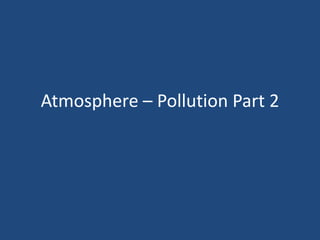
HPU NCS2200 Air pollution part 2
- 1. Atmosphere – Pollution Part 2
- 2. Regional Outdoor Air Pollution from Acid Deposition Acid deposition Wet deposition Dry deposition Wind Transformation to sulfuric acid (H2SO4) and nitric acid (HNO3) Nitric oxide (NO) Acid fog Ocean Sulfur dioxide (SO2) and NO Windborne ammonia gas and particles of cultivated soil partially neutralize acids and form dry sulfate and nitrate salts Dry acid deposition (sulfur dioxide gas and particles of sulfate and nitrate salts) Farm Lakes in deep soil high in limestone are buffered Lakes in shallow soil low in limestone become acidic Wet acid deposition (droplets of H2SO4 and HNO3 dissolved in rain and snow) Fig. 17.9, p. 428
- 3. Acid Deposition in the US Fig. 17.10, p. 428
- 4. Acid Deposition and Aquatic Systems Fish declines Undesirable species Aluminum toxicity Acid shock Water boatman Whirligig Yellow perch Lake trout Brown trout Salamander (embryonic) Mayfly Smallmouth bass Mussel 6.5 6.0 5.5 5.0 4.5 4.0 3.5 pH Fig. 17.13, p. 430
- 5. Acid Deposition, Plants, and Soil Nutrient leaching Heavy metal release Weakens trees Emissions Effects of Weather Acid deposition Dry weather Low precipitation Increased evapotranspiration Increased transpiration Lake Groundwater SO2 NOX H2O2 O3 PANs Others Increased susceptibility to frost, pests, fungi, mosses, and disease Dead leaves or needles Reduced photosynthesis and growth Tree deathDamage to tree crown Water deficit Nutrient deficiency Bark damage Direct damage to leaves and needles Leaching of soil nutrients Acids and soil nutrients Damage to fine roots Disturbance of water uptake Disturbance of nutrient uptake Soil acidification Kills certain essential soil microorganisms Release of toxic metal ions Nitrate Sulfate Magnesium Aluminum Calcium Potassium Acids Fig. 17.14, p. 432 See Connections p. 431
- 6. Acid Deposition and Humans Respiratory diseases Toxic metal leaching Decreased visibility Damage to structures, especially containing limestone Decreased productivity and profitability of fisheries, forests, and farms
- 7. OZONE DEPLETION IN THE STRATOSPHERE • Less ozone in the stratosphere allows for more harmful UV radiation to reach the earth’s surface. – The ozone layer keeps about 95% of the sun’s harmful UV radiation from reaching the earth’s surface. – Chlorofluorocarbon (CFCs) have lowered the average concentrations of ozone in the stratosphere. – In 1988 CFCs were no longer manufactured.
- 8. OZONE DEPLETION IN THE STRATOSPHERE • Ozone thinning: caused by CFCs and other ozone depleting chemicals (ODCs). – Increased UV radiation reaching the earth’s surface from ozone depletion in the stratosphere is harmful to human health, crops, forests, animals, and materials such as plastic and paints.
- 9. OZONE DEPLETION IN THE STRATOSPHERE • Since 1976, in Antarctica, ozone levels have markedly decreased during October and November.
- 10. OZONE DEPLETION IN THE STRATOSPHERE • During four months of each year up to half of the ozone in the stratosphere over Antarctica and a smaller amount over the Artic is depleted. Figure 20-19
- 11. Ozone Depleting Chemicals • Chlorofluorocarbons (CFC) • Halons • Methyl Bromide • Carbon tetrachloride • Methyl chloroform • Hydrogen chloride • Sources of CFC’s – aerosol propellants, cleaning solvents, refrigerants and foam plastic blowing agents.
- 12. Fig. 20-18, p. 486 A free oxygen atom pulls the oxygen atom off the chlorine monoxide molecule to form O2. Ultraviolet light hits a chlorofluorocarbon (CFC) molecule, such as CFCl3, breaking off a chlorine atom and leaving CFCl2. Sun Repeated many times The chlorine atom and the oxygen atom join to form a chlorine monoxide molecule (ClO). Summary of Reactions CCl3F + UV Cl + CCl2F Cl + O3 ClO + O2 Cl + O Cl + O2 UV radiation The chlorine atom attacks an ozone (O3) molecule, pulling an oxygen atom off it and leaving an oxygen molecule (O2). Once free, the chlorine atom is off to attack another ozone molecule and begin the cycle again. Cl
- 13. Effects of Ozone Depletion • Human Health – Worse sunburn – More eye cataracts – More skin cancers – Immune system suppression • Food and Forests – Reduced yields for some crops – Reduced seafood supplies due to reduced phytoplankton – Decreased forest productivity for UV sensitive tree species • Wildlife – Increased eye cataracts in some species (dogs/cats) – Decreased population of aquatic species sensitive to UV radiation – Reduced population of surface phytoplankton – Disrupted aquatic food webs from reduced phytoplankton • Air pollution and materials – Increased acid depostiion – Increased photochemcial smog – Degradation of outdoor paints and plastics • Global Climate change • Accelerated warming because of decreased ocean uptake of CO2 by phytoplakton • CFC acting as greenhouse gas.
- 14. Fig. 20-22, p. 489 This long-wavelength (low-energy) form of UV radiation causes aging of the skin, tanning, and sometimes sunburn. It penetrates deeply and may contribute to skin cancer. This shorter-wavelength (high-energy) form of UV radiation causes sunburn, premature aging, and wrinkling. It is largely responsible for basal and squamous cell carcinomas and plays a role in malignant melanoma. Epidermis Squamous Cell Carcinoma Basal Cell Carcinoma Melanoma Sweat gland Dermis Squamous cells Thin layer of dead cells Basal layer Melanocyte cells Blood vessels Ultraviolet B Ultraviolet A Hair Basalcell
- 15. Solutions • Montreal Protocol – landmark international agreement designed to protect the stratospheric ozone layer. – originally signed in 1987 ;substantially amended in 1990 and 1992. – production and consumption of chlorofluorocarbons (CFCs), halons, carbon tetrachloride, and methyl chloroform--are to be phased out by 2000 (2005 for methyl chloroform). • CFC Substitutes – HCFC’s, acidic or alkaline solutions for circuit boards – Eliminate use of foam plastic containers – Capture and recycle